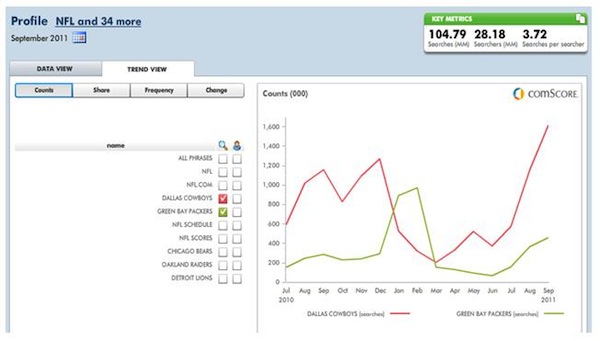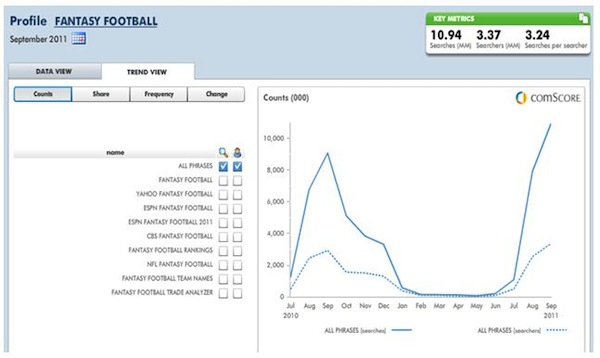It’s October, which means that football season is in full effect! Suffice to say I was eagerly anticipating a resolution to the NFL lockout to ensure there would actually be a season.
I can’t even begin to wonder what I would do on Fall Sundays and what I would talk about all week without the NFL. How would I spend my Monday mornings if not obsessing over my fantasy football team’s performance, wondering whether I would be able to pull out the win with Monday Night Football? Thankfully, the players and owners found room to agree and I was able to avoid being forced to start following regular season hockey.
Fantasy football has, in many ways, become its own favorite pastime. If your favorite NFL team is having a down year at least you can root for the guys on your fantasy team each week.
Fantasy football first emerged in the 1980s, allowing millions of armchair quarterbacks to more deeply immerse themselves in what has become an enormous time and money pit. Prior to the advent of the Internet, managing a fantasy football league was a cumbersome activity to say the least, requiring participants to peruse newspaper box scores and manually tabulate each team’s score.
The Internet created an ideal environment for the growth and adoption of fantasy football as the powerhouse of engagement that it is today. This engagement has translated into what is now a multi-billion dollar industry, making it a highly competitive market for digital marketers.
While NFL football appears tightly linked with fantasy football, the reality is that these are two different consumer markets requiring very different digital marketing strategies. Marketers who understand these differences will be much better positioned to optimize spend and attract more than their fair share of these lucrative markets.
NFL-Related Searching
Search activity for the NFL and individual teams begins to spike every year in July with the start of training camp and grows over the next few months.

More than 28 million people conducted 105 million searches containing either “NFL” or team name searches in September 2011 (e.g. Bears, Giants, Raiders). These searches tend to peak each year in October, and we anticipate a similar peak this month when every fan still believes their team has a chance (well, except for maybe the Dolphins). Searches decline in November as many teams fall out of the playoff race, but then December sees a pickup in activity as the final playoffs races are decided.
Overall, however, this sort of general NFL-related search activity remains active throughout the season and presents ample opportunity to market to NFL fans with at least 40 million related searches each month. This is especially important for any NFL league sponsors, heavy NFL advertisers like beer and auto companies, and NFL apparel retailers, from both a direct response and branding perspective.
(As an interesting sidebar, the Dallas Cowboys tend to be the most searched for team every season, although something as trivialas winning the Super Bowl and the Cowboys missing the playoffs at least allowed the Green Bay Packers a brief moment in the sun back in January and February. The Cowboys have once again assumed the mantle of “most searched team.”)

“Dallas Cowboys” vs. “Green Bay Packers” searches, broad-matched
Fantasy Football Searching
Fantasy football searching exhibits some different patterns from the more general NFL-related search, and relevant marketers should take note. Every year the fantasy football providers compete mightily to win your business. Whether they want you to renew your league, expand your subscriptions, or to try out their service as a first time subscriber, they all know that search plays a critical role in your NFL and fantasy football navigation.
The main difference between fantasy football searchers and regular NFL searchers is the peak of activity. NFL searchers open the search season in July and more or less continue it until the season ends in February. Search activity on fantasy football, however, is heavily concentrated in August and September, with a peak in September.
As illustrated below, “fantasy football” search volume peaked in September 2011 with 3.4 million searchers and nearly 11 million searches. But there is a precipitous decline as soon as the season starts in September, as many fantasy footballers have already conducted the majority of their research and preparation in advance of the season. Once fans have their fantasy leagues set, they are less likely to search for information and insight and instead rely on bookmarks and direct URL navigation for ongoing team management.

Reviewing the search click-throughs on fantasy football terms, 14.4 million out of the 15.2 million total search click-throughs In September (95 percent) were organic. Therefore, “evergreen” SEO content around fantasy football should be an incredibly important part of any fantasy football marketer’s customer acquisition strategy. Although the window for conversion is very short, the need to work on your SEO rankings year round is essential for those wanting to capitalize on the high-demand part of the season.

Total Search Click-throughs and Click Destinations for “Fantasy Football” broad-matched
Remember that “Related” Does Not Equal “Exact”
While the relationship between the NFL and fantasy football is obvious, it’s necessary for search marketers to understand the subtle but important difference in search patterns and behavior. While both interests have a heavily overlapping audience, they are still different markets representing different opportunities to marketers.
A simple analysis of the search data clearly demonstrates important insights for how to best maximize your digital marketing investment. This sort of analysis can be applied to any overlapping markets to reveal actionable insights that will drive success.



